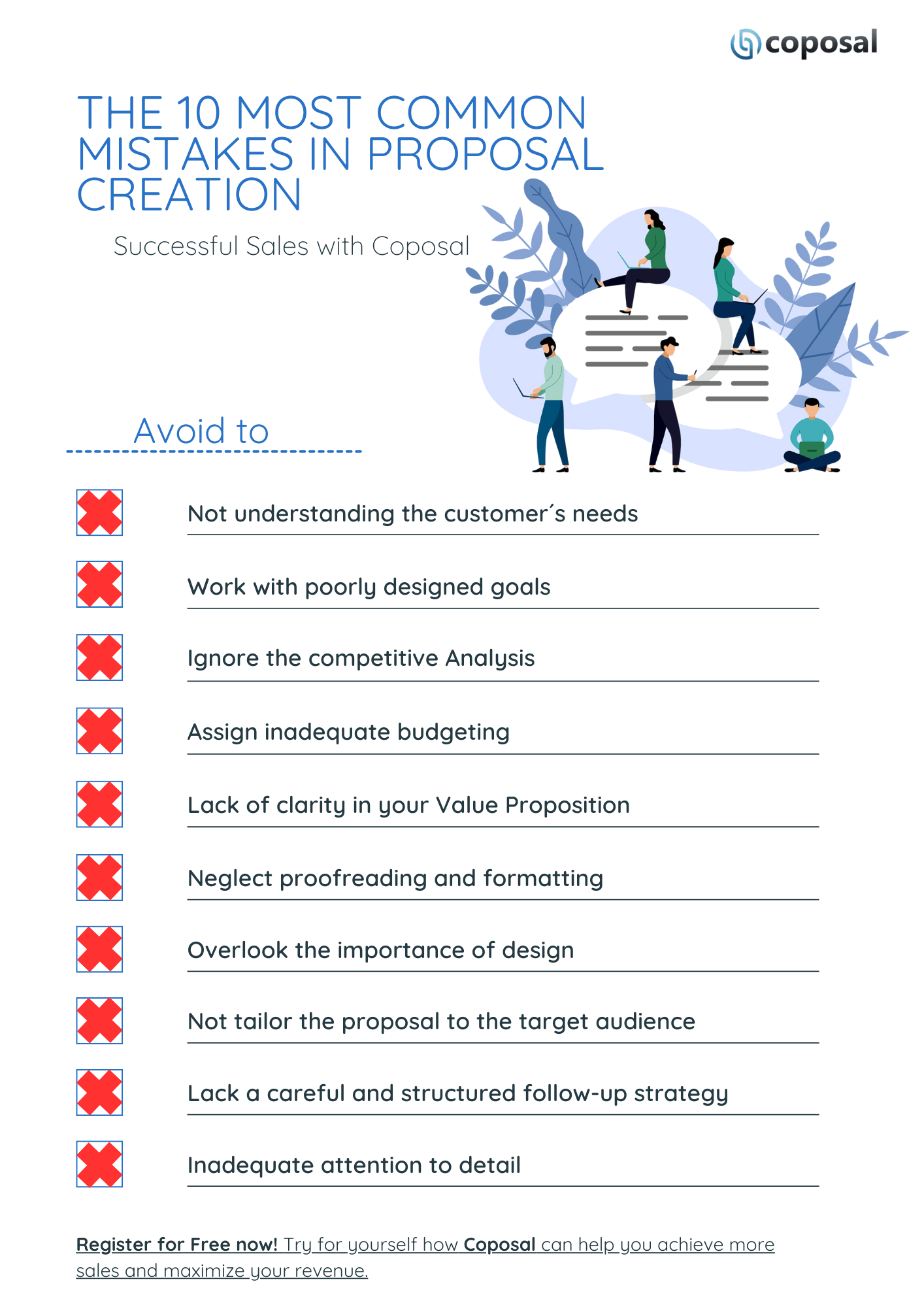 Creating a proposal is a crucial step in acquiring new business or securing projects. However, many make avoidable mistakes that can easily be avoided.
Creating a proposal is a crucial step in acquiring new business or securing projects. However, many make avoidable mistakes that can easily be avoided.
In this article, we address the 10 most common errors in proposal creation and provide insights on how to effectively avoid these pitfalls.
Table of Contents
- Not Understanding the Customer's Needs
- Poorly Defined Goals
- Ignoring Competitive Analysis
- Inadequate Budgeting
- Lack of Clarity in Value Proposition
- Neglecting Proofreading and Formatting
- Overlooking the Importance of Design
- Not Tailoring the Proposal to the Target Audience
- Lack of Careful Follow-Up
- Inadequate Attention to Detail
1 - Not Understanding the Customer's Needs
 One of the most fundamental errors in creating a proposal is not fully understanding the customer's needs.
One of the most fundamental errors in creating a proposal is not fully understanding the customer's needs.
This often happens due to lack of thorough research or not asking the right questions in initial discussions.
Without a clear understanding of what the customer is looking for, it is difficult to effectively tailor the proposal.
2 - Poorly Defined Goals
A proposal should clearly outline the goals of the project or partnership. However, many proposals lack specific and realistic goals.
This can lead to confusion and rejection of the proposal by the customer. It is important to define clear and achievable goals that align with the customer's expectations.
3 - Ignoring Competitive Analysis
 Another common mistake is overlooking the competitive analysis.
Another common mistake is overlooking the competitive analysis.
Understanding the competitive landscape is crucial for effectively positioning your proposal.
If the strengths and weaknesses of competitors are not evaluated, this can result in a proposal lacking differentiation and not standing out from others.
4 - Inadequate Budgeting
Budgeting errors can significantly impact the success of a proposal. Underestimating costs or making promises beyond budget constraints can lead to unrealistic expectations and customer dissatisfaction.
It is important to conduct a thorough cost analysis and ensure that the proposed budget is both realistic and achievable.
5 - Lack of Clarity in Value Proposition

A proposal should clearly articulate the value proposition of the proposed solution or partnership.
However, many proposals in this area are inadequate as they do not effectively communicate the benefits.
Instead, they focus too much on features without highlighting how they address the customer's needs and pain points.
6 - Neglecting Proofreading and Formatting
Typographical errors, grammar mistakes, and inconsistent formatting can undermine the professionalism of a proposal.
Neglecting proofreading and formatting not only reflects poorly on the author but also raises doubts about attention to detail and the quality of the proposed solution.
7 - Overlooking the Importance of Design
 The visual presentation plays a crucial role in the effectiveness of a proposal. However, many proposals suffer from unattractive design and inconsistent branding.
The visual presentation plays a crucial role in the effectiveness of a proposal. However, many proposals suffer from unattractive design and inconsistent branding.
Investing in high-quality design elements can significantly enhance the overall impact and professionalism of the proposal.
8 - Not Tailoring the Proposal to the Target Audience
Generic proposals that do not address the specific concerns and preferences of the audience are unlikely to resonate with customers.
It is important to tailor the proposal to the needs and expectations of the target audience and demonstrate a deep understanding of their challenges and goals.
9 - Lack of Careful Follow-Up

Effective follow-up is crucial for the successful implementation of a proposal.
However, many sales professionals neglect communication after submission, assuming the proposal speaks for itself.
After submitting your proposal, reach out to the recipient to address any questions or concerns.
Also, seek feedback to gain insights into areas for improvement and enhance your proposal writing skills.
Implementing a solid follow-up plan can also help address existing concerns or objections and demonstrate commitment to the customer's success.
10 - Inadequate Attention to Detail
Details matter. Failing to pay attention to the nuances of your proposal can diminish its overall impact and create room for misunderstandings.
Review every aspect, from formatting and grammar to data accuracy and alignment with the recipient's requirements.
Attention to detail builds trust in your professionalism and commitment.
Summary
To create proposals that resonate with customers and generate business, it is important to avoid these common errors.
By understanding the customer's needs, defining clear goals, conducting a thorough competitive analysis, and adhering to best practices in proposal creation, you can significantly increase the success rate of your proposals.
 Reading Tip: If our article has been helpful and you want to learn more about potential pitfalls in creating proposals, continue reading here: "Understanding the Structure and Content of a Proposal"
Reading Tip: If our article has been helpful and you want to learn more about potential pitfalls in creating proposals, continue reading here: "Understanding the Structure and Content of a Proposal"
Frequently Asked Questions about Errors in Proposal Creation
What are the consequences of these errors?
These errors can lead to proposals not impressing customers, resulting in missed opportunities and lost business.
How can I improve my skills in writing proposals?
Creating good proposals requires practice, attention to detail, and a willingness to seek feedback and learn from mistakes.
Is there a template I can use to create effective proposals?
While many proposal templates are available, it is important to customize them to meet the specific needs and preferences of each customer.
How do I find out if my proposal is well-received?
Feedback from the client as well as any follow-up discussions or negotiations can provide insight into the acceptance of the proposal.
Can these errors be corrected after submitting a proposal?
While it is challenging to correct errors after submitting a proposal, proactive communication and addressing any concerns raised by the customer can help salvage the situation.